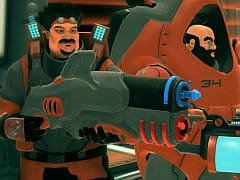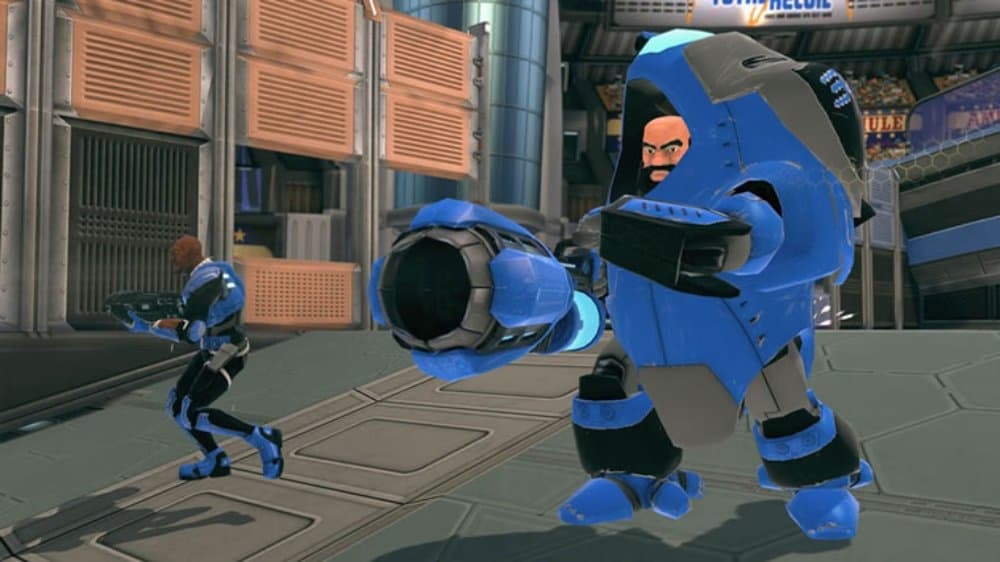You can trust VideoGamer. Our team of gaming experts spend hours testing and reviewing the latest games, to ensure you're reading the most comprehensive guide possible. Rest assured, all imagery and advice is unique and original. Check out how we test and review games here
Online shooters are resistant to change – partially because of how hard it is to advance the genre but, when dwelling on how the last big innovation was the (now mandatory) perk system, you realise there’s not normally much outside of simple team deathmatch and objective modes. It’s very rare to see a studio invent something shiny and new that works.
Monday Night Combat is an immediately exciting prospect, then, seeing as it competently merges a third-person shooter with an established system of tower defence. It’s a particularly shrewd touch: blending one of gaming’s most established genres with its most infantile.
The shrewd concept is matched by a complimentary aesthetic – a bright cartoon arena that’s complete with resplendent cheering crowds, an obnoxious announcer and messages from sponsors. There’s an obvious nod to Valve’s iconic work with Team Fortress 2, though Monday Night Combat – which isn’t without its own charms – never quite manages to seriously challenge its source of inspiration. Though the Support is French, which I like.
The real meat comes from the unique strategies at your employ. We’ve seen elements of similar strategy games directly inserted into a third-person perspective before – going way back to 2000’s Sacrifice – but the concept is still mostly unexplored territory. It’s most immediate effect on a team-based online game is the option for everyone (not just the Support class – but more on that later) to construct turrets on pre-determined base structures.
Turrets come in four varieties, with your bread-and-butter staple being the pew-pew Lazer Blazer, with its cheap cost and all-purpose simplicity proving essential for all types of play. Conversely you have the specialist Shaveice turret, which emits a chilly (and probably glum) aura that slows down anything near it – useful for choke points and killzones, but not much else.
Artillery is provided by the paper thin Long Shot – the turret of choice for offensive play, actually, seeing as you can upgrade it to fire halfway across the map. Finally you have the Rockit turret, which is expensive, bulky and slow, making it a complete pain in the bum to keep alive. On the flipside, whooshing rockets have predictably devastating results.
On the other hand, you’ve got the droids. Assortments of these pile out of spawning zones and march like armoured, robotic lemmings to their destination – the Moneyball, a floating ornate orb of coins begging to explode. In Blitz mode the droids are your sole foes, and they try and get at your Moneyball over a pre-set series of waves. Crossfire, however, has you going 6v6 against another human team, each with your own gaggle of robots soldiering on towards the enemy Moneyball.
Many of the permutations will be familiar to anyone who’s sampled their fair share of tower defence titles: the general fodder, the quick attackers, the long-range units et al. There’s also the Jackbot XL, a juddering behemoth of towering offensive capabilities that drops loads and loads of money when toppled.
Your turrets, then, are as much about blasting away the unending swathes of droids as they are for deterring any human Pros. Each turret can be upgraded two times, with level 3 encampments both costly and devastating. It all costs dollars, though, which are doled out for taking out opposing forces: you’ll need to kill a lot of stuff to get your max out of your base, and a very skilful defence to keep it from being destroyed.
Money is also spent on upgrading your own personal set of abilities which, depending on which of the game’s six Pro’s (read: classes) you’re playing as, offer up other, deeper avenues of tactical possibility. By far the most popular class at the moment is the Assassin, a lithe ninja with the ability to cloak, leap, backstab (which kills most characters instantly) and drop smoke bombs all over the place. They are, however, paper-thin. And you’ll probably never get a chance to play as one if you’re even remotely interested in tactically balancing your teams.
Assault and Tank fill out more general-purpose roles, roughly balancing offence and defence right down the middle. Assault, other than using the mandatory assault rifle, can ping out rather dastardly grenades with alarming regularity. The sturdier Tank has a laser that can set enemies on fire at short range, as well as fire precise long-range shots, and has a swinging melee attack that tears through everything in his path.
Like the Tank, the Gunner can deploy himself into a sturdy offensive fortress. Unlike the Tank, it’s actually useful when the Gunner does it – firing out a steady steam of pain from a ghastly oversized minigun. He can also throw clumps of grenades – he doesn’t mess about, basically. And he’s slow.
Support acts as a mix of traditional Medic and Engineer classes. He can heal turrets and teammates, leech life from enemies, throw down his own personal turret, hack (friendly turrets for extra range, enemy turrets for a laugh) and chuck grenades that take days to explode but do massive damage.
And, finally, there’s the Sniper. He snipes.
Each Pro’s three skills – which, like turrets, can be upgraded with money – are mapped to similar face buttons, meaning switching from class to class is fairly cohesive and not a complete nightmare.
It’s also unwise to forget the other embellishments scattered around each map – purchasable jump pads, lightning strikes, bonus droids for cash and a dancing mascot you can shoot for loads of money: all things you’ve got to account for in general play.
Perhaps unbelievably, it all works – despite being a little overwhelming when you first pick up the controller. Monday Night Combat doesn’t quite work like a standard shooter, but you quickly learn to bury yourself with the marching robot masses and slowly advance up the line. Patience is rewarded, as neglecting your droids means you won’t be able to capture the enemy Moneyball.
The problem, though, is that the classes could do with some balancing. It doesn’t really detract from the overall game – and, yes, there’s a precedent: Bad Company 2 plays just fine despite the fact the medic is an unstoppable juggernaut – but there’s a clear bias in favour of certain classes at the moment. In the defence of developer Uber Entertainment, the game uses a devilishly clever Xbox LIVE workaround to tweak the classes without requiring you to download endless Title Updates.
While much of the game shines, map design and variety falls by the wayside. Blitz mode only has one to choose from – the aptly titled Blitz Arena – leaving the other four for Crossfire. They all sing to a similar tune: entirely symmetrical, with two levels, peppered with packed-in corridors making way for wide-open central halls and team spaces. Functional arenas, perhaps, but hardly the next 2fort or Facing Worlds.
As always, it can be frustrating when playing with random players. Your skill upgrades don’t carry over to other classes, so you’ll occasionally end up in tricky predicaments when, half-way through a game, everyone will switch to your class – leaving you trying to weigh up the team’s tactical need for variety against whether you can afford to let go of the thousands of dollars you’ve spent.
Even worse: the delicately constructed online mode tumbles like a house of cards as soon as a team of even basic competence assembles itself against public randoms. This is true for so many online shooters, but there’s a clear gap in the game’s scoring system: truly defensive play will usually put you at the bottom of the table, but failure to do it will almost definitely cause your team to lose.
Uber could learn a thing or two from something like, say, Bad Company 2, and the way it awarded medics more points for healing their squad than gaining a kill, effectively encouraging even random players to emphasise teamplay. As it stands, you’ll probably want to buddy up with some friends before braving the online masses.
Still, Monday Night Combat is an adeptly handled game. It’s an exciting, occasionally thrilling online shooter with a genuinely engaging hook, and a clever hodgepodge of many pre-existing trends to boot. What’s most exciting, though, is how the game (and the franchise) could develop in the months and years to come. Tower Defence is no longer the staple diet of iPhone and Flash developers.
Monday Night Combat
- Platform(s): PC, Xbox 360, Xbox One
- Genre(s): Action, Indie, Shooter, Sports, Strategy, Third Person

/https://oimg.videogamer.com/images/d715/monday_night_combat_21.jpg)
/https://oimg.videogamer.com/images/5546/monday_night_combat_23.jpg)






